This article has multiple issues. Please help improve it or discuss these issues on the talk page . (Learn how and when to remove these template messages)
|
Layered clothing is the wearing of multiple garments on top of each other.
This article has multiple issues. Please help improve it or discuss these issues on the talk page . (Learn how and when to remove these template messages)
|
Layered clothing is the wearing of multiple garments on top of each other.
Often, clothing combines two adjacent layers, as in the case of warm undergarments that provide both comfort and insulation. Layered clothing usually consists of three layers. They are identified as follows:[ citation needed ]
The purpose of the inner layer is to draw sweat away from the skin to the outer layers to make them feel warmer. If a piece of clothing does not transfer moisture well, it is not strictly an inner layer garment but simply a mid-layer garment. Wool has a combination of wicking and water-repelling properties [1] and is highly odour-resistant. [2]
The mid layer is to provide additional insulation. Mid layer material includes wool, which provides insulation and has the capacity to absorb moisture. Synthetic fiberfill, such as polyester fiber, is used similarly to down.

The outermost clothes are called the shell layer, but only if they block wind or water or have good mechanical strength. Both "soft" and "hard" shell jackets and layers exist. Hard shells are commonly woven fabrics and do not rip. Soft shells may rip more easily. Examples of a shell layer include plastic raincoats and water-repellent coatings, which are often used. Before waterproof-breathable shells were invented, the "60/40" (60% cotton, 40% nylon) parka was widely used. Soft shells are not "waterproof".
The term soft shell is used to describe garments that combine partial or full water resistance with partial or full wind-breaking ability. Soft shell fabrics can come with a wicking layer. In many cases, insulation is combined.
| | This section needs expansion. You can help by adding to it. (March 2024) |
Combining different garments in layers can be used to create a variety of outfits. The wearer can shed layers according to changes in temperature. [3]
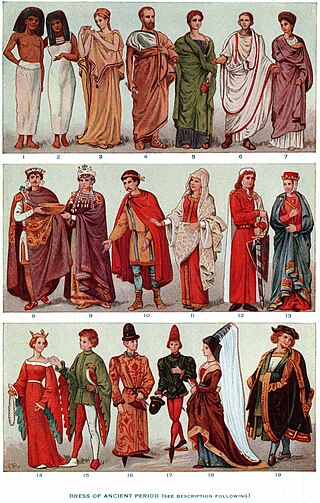
Clothing is any item worn on the body. Typically, clothing is made of fabrics or textiles, but over time it has included garments made from animal skin and other thin sheets of materials and natural products found in the environment, put together. The wearing of clothing is mostly restricted to human beings and is a feature of all human societies. The amount and type of clothing worn depends on gender, body type, social factors, and geographic considerations. Garments cover the body, footwear covers the feet, gloves cover the hands, while hats and headgear cover the head, and underwear covers the private parts.
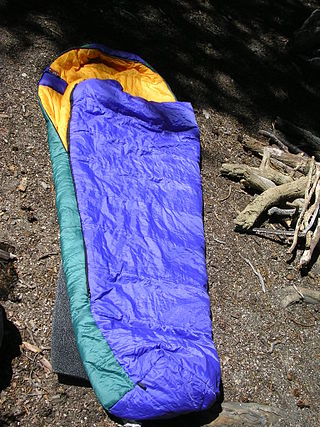
A sleeping bag is an insulated covering for a person, essentially a lightweight quilt that can be closed with a zipper or similar means to form a tube, which functions as lightweight, portable bedding in situations where a person is sleeping outdoors. It is also commonly used indoors for people who do not have beds or at sleepovers. Its primary purpose is to provide warmth and thermal insulation through its synthetic or down insulation. It also typically has a water-resistant or water-repellent cover that protects, to some extent, against wind chill and light precipitation, but a tent is usually used in addition to a sleeping bag, as it performs those functions better. The bottom surface also provides some cushioning, but a sleeping pad or camp cot is usually used in addition to that purpose. The bottom surface of a sleeping bag may be moderately water repellent, but a plastic tarp or groundsheet is often used to protect against moist ground.

A dry suit or drysuit provides the wearer with environmental protection by way of thermal insulation and exclusion of water, and is worn by divers, boaters, water sports enthusiasts, and others who work or play in or near cold or contaminated water. A dry suit normally protects the whole body except the head, hands, and possibly the feet. In hazmat configurations, however, all of these are covered as well.

A raincoat is a waterproof or water-resistant garment worn on the upper body to shield the wearer from rain. The term rain jacket is sometimes used to refer to raincoats with long sleeves that are waist-length. A rain jacket may be combined with a pair of rain pants to make a rainsuit. Rain clothing may also be in one piece, like a boilersuit. Raincoats, like rain ponchos, offer the wearer hands-free protection from the rain and elements; unlike the umbrella.

Extreme cold weather clothing is clothing for arctic or mountainous areas. Its primary function is to trap air as an insulator to prevent heat loss from the wearer's body. Secondary and necessary is to conduct water vapor away from the body to keep the insulating layers dry. A shell keeps the wind from disturbing the still air in the insulating layers. In warmer conditions, the shell protects from water intrusion.

Gabardine is a durable twill worsted wool, a tightly woven fabric originally waterproof and used to make suits, overcoats, trousers, uniforms, windbreakers, outerwear and other garments.

Mukluks or kamik are soft boots, traditionally made of reindeer (caribou) skin or sealskin, and worn by Indigenous Arctic peoples, including Inuit, Iñupiat, and Yup'ik.

Thinsulate is a brand of synthetic fiber thermal insulation used in clothing. The word is a portmanteau of the words thin and insulate, trademarked by 3M. The material is made by the 3M Corporation and was first sold in 1979. It was originally marketed as an inexpensive alternative to down; at the time, 3M claimed it was twice as warm as an equivalent amount of any natural material.
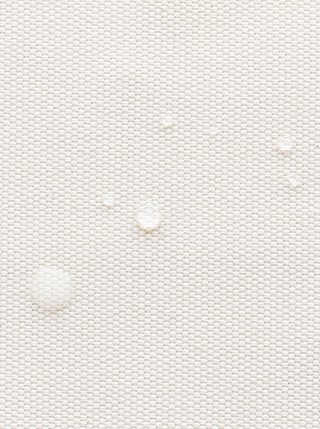
Waterproof fabrics are fabrics that are, inherently, or have been treated to become, resistant to penetration by water and wetting. The term "waterproof" refers to conformance to a governing specification and specific conditions of a laboratory test method. They are usually natural or synthetic fabrics that are laminated or coated with a waterproofing material such as wax, rubber, polyvinyl chloride (PVC), polyurethane (PU), silicone elastomer, or fluoropolymers. Treatment could be either of the fabric during manufacture or of completed products after manufacture, for instance by a waterproofing spray. Examples include the rubberized fabric used in Mackintosh jackets, sauna suits, and inflatable boats.

Durable water repellent, or DWR, is a coating added to fabrics at the factory to make them water-resistant (hydrophobic). Most factory-applied treatments are fluoropolymer based; these applications are quite thin and not always effective. Durable water repellents are commonly used in conjunction with waterproof breathable fabrics such as Gore-Tex to prevent the outer layer of fabric from becoming saturated with water. This saturation, called 'wetting out,' can reduce the garment's breathability and let water through. As the DWR wears off over time, re-treatment is recommended when necessary. Many spray-on and wash-in products for treatment of non-waterproof garments and re-treatment of proofed garments losing their water-repellency are available.

Sportswear or activewear is athletic clothing, including footwear, worn for sports activity or physical exercise. Sport-specific clothing is worn for most sports and physical exercise, for practical, comfort or safety reasons.

A tuilik is an Inuit watertight jacket, used when paddling a kayak. It is sealed at the face, at the wrists and around the cockpit coaming. In this way the paddler can capsize and come back upright without getting wet, and without getting any water into the kayak.
Hiking equipment is the equipment taken on outdoor walking trips {{Citation needed}}. The duration, distance, planned activities, and environment impacts equipment selection. For example, a short day hike across flat farmland versus trekking in the Himalayas would call for different types of equipment. Applicable government regulations may also be a consideration when selecting equipment {{Citation needed}}.
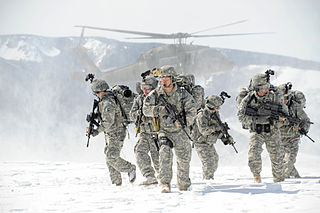
The Extended Cold Weather Clothing System is a protective clothing system developed in the 1980s by the United States Army Natick Soldier Research, Development and Engineering Center, Natick, Massachusetts. The first generation ECWCS consisted of parka and trousers plus 20 other individual clothing, handwear, headwear and footwear items which are used in various combinations to meet the cold weather environmental requirements of the US military. The Extended Climate Warfighter Clothing System, or Gen III ECWCS, is designed to maintain adequate environmental protection in temperatures ranging between −60 and +40 °F.
Ventile, is a registered trademark used to brand a special high-quality woven cotton fabric first developed by scientists at the Shirley Institute in Manchester, England. Originally created to overcome a shortage of flax used for fire hoses and water buckets, its properties were also useful for pilots' immersion suits, but expensive and leaky if exposed to sweat or oils.
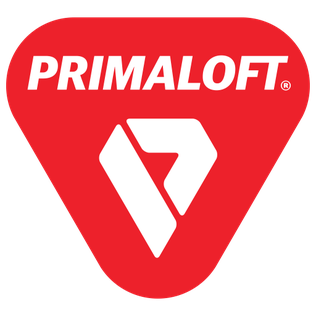
PrimaLoft® is a brand of patented synthetic microfiber thermal insulation material that was developed for the United States Army in the 1980s. PrimaLoft is a registered trademark of PrimaLoft, Inc., the brand's parent company.
Nikwax Analogy is a two-component fabric system for weatherproof clothing based on "biomimicry" of fur.
Clothing insulation is the thermal insulation provided by clothing.

Traditional Inuit clothing is a complex system of cold-weather garments historically made from animal hide and fur, worn by Inuit, a group of culturally related Indigenous peoples inhabiting the Arctic areas of Canada, Greenland, and the United States. The basic outfit consisted of a parka, pants, mittens, inner footwear, and outer boots. The most common sources of hide were caribou, seals, and seabirds, although other animals were used when available. The production of warm, durable clothing was an essential survival skill which was passed down from women to girls, and which could take years to master. Preparation of clothing was an intensive, weeks-long process that occurred on a yearly cycle following established hunting seasons. The creation and use of skin clothing was strongly intertwined with Inuit religious beliefs.

Textile performance, also known as fitness for purpose, is a textile's capacity to withstand various conditions, environments, and hazards, qualifying it for particular uses. The performance of textile products influences their appearance, comfort, durability, and protection. Different textile applications require a different set of performance parameters. As a result, the specifications determine the level of performance of a textile product. Textile testing certifies the product's conformity to buying specification. It describes product manufactured for non-aesthetic purposes, where fitness for purpose is the primary criterion. Engineering of high-performance fabrics presents a unique set of challenges.